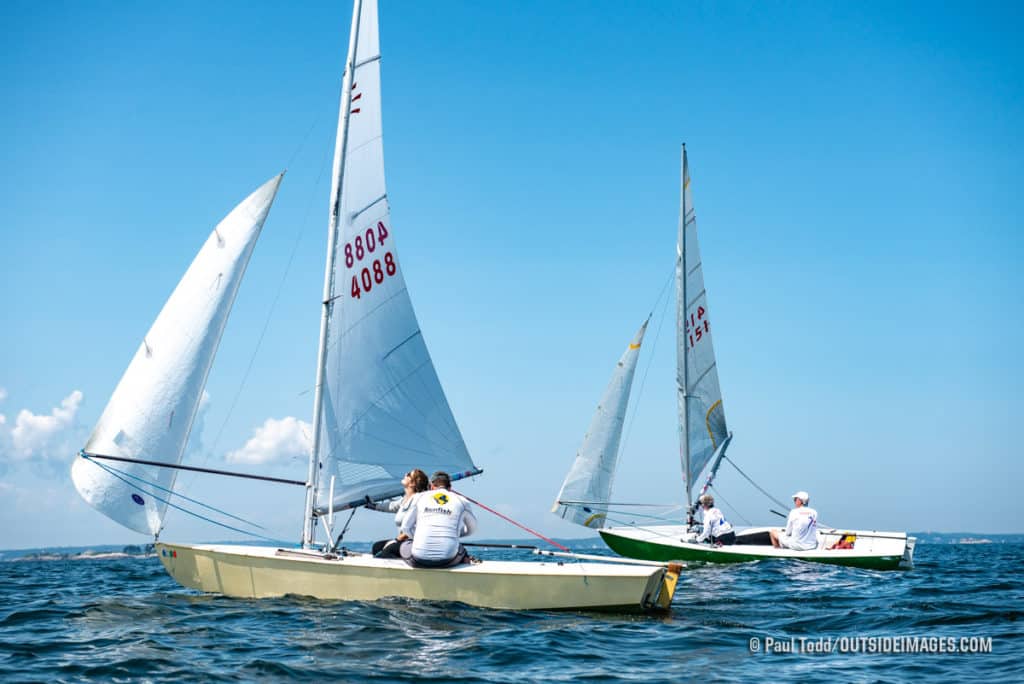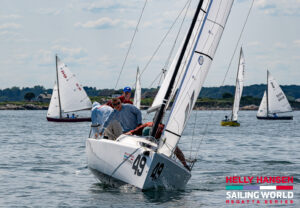Mark Buruchian and his son, Kevin, stand shoulder to shoulder between their respective Comets. Mark’s hull No. 3952 is white and well-kept. Kevin’s hull, No. 4088, is a faded yellow patina showing its age, but it’s plenty tricked out for an old Comet. Colored lines crisscross the cockpits of each. Dad has his preference for how controls run. Kevin’s is a work in progress, subtly changing from year to year, as Comets do.
“The Comet class is a 16-foot, one-design, two-person boat that was started back in…”
Mark pauses and looks to his son for the answer.
“You’d be better at that than me,” Kevin responds, as if his old man should know. “Maybe the fifties or sixties?”
“I’m not exactly sure,” Mark answers, “but it’s been around for more than 60 years. That I know.”
Technically, it was 1932 when the Comet class came to be, chimes in fellow competitor Bradley Meade, from West Haven, Connecticut, who has raced Comets for exactly 65 years.

But, really, who’s counting? And who cares? The happy truth is the Comet class has been around for a long time, but if you were to peel back the top cover of Helly Hansen NOOD Regatta competitor Talbot Ingram’s new Comet, you’d agree the new-generation boat is sexier than ever. Built recently by Whitecap Composites in nearby Peabody, Mass., Ingram’s boat has rounded tanks that are more comfortable for his wife Carol Lee. It’s strung with high-tech ropes and all the micro-adjustments any tweaker-sailor would appreciate.
Whitecap built five new boats last year, a few before that, and three more will be unplugged this year, so you could say things are on the up for the Comet class. There’s no local fleet, so Ingram, the Buruchians, and the five other teams racing in Marblehead are a sortie of a class that today maintains strongholds up and down the East Coast, out to Ohio and offshore to Bermuda.
“The fun part was traveling to regattas”
Once upon a time, New Jersey’s Highfield Lake Comet fleet was the biggest around, says Mark, who graduated as a top junior Sunfish sailor to the Comet in 1973. He then bought his first boat with a couple thousand dollars he inherited from his aunt and uncle.
“The fun part was traveling to regattas,” Mark says. “Once we got our driver’s licenses, we went all over upstate New York and New England in my father’s van, sleeping on yacht club floors, tents or wherever else we could.”
But never in the boat. “ That would not be comfortable,” he says.
As the family legend goes, Mark brought Kevin onboard to crew at age four and then selfishly, he says, started letting him skipper soon after. “I knew if I got him to skipper the boat, he would stay with it longer,” says Mark. “So I started crewing for him.”
“It’s a very performance-based boat”
Kevin, now an engineer, eventually went off to college, got married, and found himself a wedding present; a once-neglected and orphaned boat now appropriately named, “Gifted.” He and the Mrs., have a newborn nowadays, so he gives the old girl as much attention as he can, but the boat-work never really stops. He loves to sneak away and work on it.
“It’s a very performance-based boat,” he says, pointing out that no one Comet is the same these days. On most boats, the sail controls come back to the skipper; there’s the hiking strap adjustment, centerboard, outhaul and cunningham that he can adjust on the fly.
For his crew, Stefanie Casella, there’s the jib sheets, whisker pole and the shroud adjustments that keep the big mainsail powered. “One of the benefits of the class is that it’s still an open-engineered kind of boat where you can tweak and tinker,” Kevin says. “Especially with the sidestays moving on tracks and the big main with lots of power.”
It’s a really fun boat that planes in light air, he says, and he was happy to transition out of college dinghies and back into a more cerebral sort of boat. “When it’s tuned right it feels beautiful,” he says. “You can let go of the tiller and it sails itself.”
“You can also really feel it when it’s not in tune,” he adds. “The rudder is big, old-school and rounded and there’s a lot of water going past it. If the boat is out of tune, you’ll feel it in your wrist by the end of the day.”
The old man agrees with a nod. He’s taught his son well and now it’s time to launch and see if the trademark “Buruchian Flyer” works in Marblehead. Maybe, just maybe, we’ll see either one of them streaking in like a Comet from the left corner.









